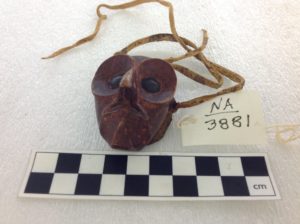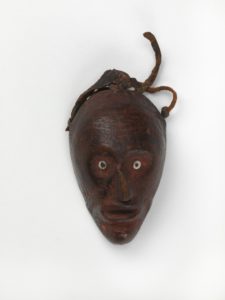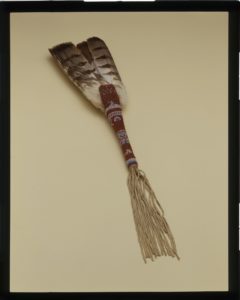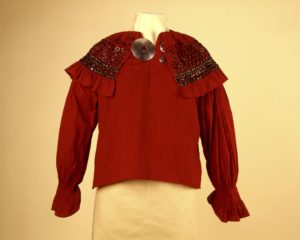Author: Terry Anne Wildman
School/Organization:
Overbrook Elementary School
Year: 2014
Seminar: Native American Voices: The People – Here and Now
Grade Level: 4
Keywords: History, Lenni-Lenape People, NAGPRA, Native American Voices Exhibit
School Subject(s): Social Studies
This unit explores the history both present and past of the Lenni-Lenape People. Students in our elementary schools learn of the history of Native Americans. Rarely do they look at what Native peoples are doing in the present tense. Native Americans have been actively working towards rebuilding their communities and language since Europeans first set foot in North America. They have been politically active, both locally and nationally, to re-member their own Nations, regain sovereignty, and educate Americans about the importance of keeping their cultures alive.
This unit is created for fourth graders, but can be easily modified for fifth graders, who study American History. Students will learn of the history of the Lenni-Lenape people and why they moved from the eastern part of Pennsylvania, New Jersey, Delaware and New York. While integrating literacy and social studies skills, they will explore cultural objects of the Lenni-Lenape people, create soapstone carvings, reflect on events surrounding treaties and migration, and visit the Native American Voices: The People – Here and Now exhibit at the Penn Museum. The exhibit will be open until 2019, with objects that will rotate in and out of the exhibit so that we can benefit from the hundreds of objects that Penn Museum has in its collection.
Download Unit: Wildman-Terry-Anne-unit.pdf
Did you try this unit in your classroom? Give us your feedback here.
American History, as we know it, has traditionally focused on the successes of immigrants and their struggles to survive and thrive in the “New World.” Students have learned of the conflicts between Europeans and Native Americans and how Native Americans took sides during the French and Indian War, the American Revolution, and the War of 1812. They have learned about treaties made between Native Americans and the United States Government and they have learned that Europeans would not have survived if not for the help of Native Americans. In the Philadelphia area, the Lenni-Lenape Tribe, who were a part of the Algonquian language family, lived and thrived along the Delaware River. When William Penn arrived, Penn entered into a treaty with the Lenni-Lenape, in the hopes of keeping peaceful relations. Eventually they were forced to move west and today there are descendents of the Lenni-Lenape living in Philadelphia, New Jersey, Oklahoma, Kansas, and Ontario, Canada. They are working to keep their culture alive including their land, language, arts, and ceremonies. Today they continue to fight for sovereignty, civil rights and the health and well-being of their people. The story of the Lenni-Lenape did not end with the removal from their land. It is important that students today learn that not only the Lenni-Lenape tribe, but many Native American tribes are alive and well and continue to actively fight for their civil rights in the United States.
This unit is intended for students in Grade 4 and it can be modified to fit in the social studies curriculum for fifth graders. Fourth graders focus on Pennsylvania history, which includes the study of Pennsylvania Native Americans. Fifth graders focus on American History, including the study of Native Americans in the United States. The objectives of the unit will include the following:
Strategies that I plan on using include exploring the history of the Lenni-Lenape people through objects that are in the Native American Voices exhibit. Students will use these objects to understand the Lenni-Lenape culture, art, and traditions and build a foundation for understanding how Native Americans lived in America before settlers and immigrants moved here. Student will explore their own culture by interviewing family members to gain as much information as they can about traditions, celebrations, history, language, and art. They will present information about their culture and bring an object that represents something important about traditions or celebrations in their culture. Students will read stories written from American textbooks and stories written by the Lenni-Lenape people to compare and contrast information to understand perspective. Students will gather information about their own culture and traditions and write an informational narrative about their own backgrounds. Students will be able to hear what a member of the Lenni-Lenape nation is doing today – what type of work they have chosen, where they went to school, what issues they continue to have living in urban America, the ceremonies and rituals they continue to practice today, and how they keep their histories alive and their community together. They will be able to ask questions from this guest speaker and hopefully understand the importance of traditions and community. Students will develop “detective” skills that historians use to find out information about objects that are found in historic places throughout the country. They will use these skills to understand and interact with the Native American Voices exhibit, which they will visit at the end of the unit.
Lesson One: Objectives: Students will be able to (SWBAT) explore ways to communicate with people of other cultures in order to (IOT) listen critically and respond intelligently as individuals. Materials: Chart paper/Smart board Vocabulary: culture, traditions paper Markers Introduce “culture” by defining the word and describing what makes a culture. Brainstorm and chart examples of American culture. Ask students how they would communicate and get to know another’s culture if they do not understand their language. Discuss responses. Allow students to work in small groups to create a list of ideas they would use to communicate. Have groups “try” these ideas on another group (pretending they do not understand the first group’s language). When all groups have had a chance to try their ideas, discuss with the class what problems they encountered and what misunderstandings came from their first “encounter.” List students’ responses and discuss challenges and successes that each partnership encountered. Assessment: Student reflections on the challenges of communicating with other cultures. Lesson Two: Objective: SWBAT explore their own culture and traditions IOT present an object that represents an important aspect of their culture. Materials: Paper Vocabulary: heritage Chart paper/Smart board Review the term culture and ask students to think about what makes their own culture different from others. (Include dress, homes, school, celebrations, traditions, etc.) Ask if they know where these things came from. Students will be asked to explore their own culture either by 1) interviewing family members, or 2) researching information about their country of origin, including language, art, food, celebrations, traditions, connections, landscape and place. Students will be asked to bring in an object that represents their culture including foods, celebration object, traditional clothing, etc. Students will present information on their heritage along with an activity, piece of art, tradition, or food that is representative of their country of origin. Assessment: Create rubric to assess presentation and students’ understanding of their culture and traditions. Lesson Three: Objective: SWBAT explore the history of the Lenni-Lenape people IOT compare and contrast their stories with “textbook” stories Materials: Figure 1 Drawing/Response worksheet #1 – see Appendix The Indians of New Jersey: Dickon Among the Lenapes Student’s Social Studies Textbooks Venn diagram worksheet Vocabulary: stereotypes Begin with a Lenni-Lenape object to draw – use Drawing/Response Worksheet #1 (See Figure 1 below – Delaware Mesingwe Maskette na3881.) Read an excerpt of The Indians of New Jersey: Dickon Among the Lenapes on descriptions of clothing, hunting, vision quests, ceremonies, or rituals. Discuss what students know about Native Americans. Introduce the word stereotypes and create a working definition. Read the creation story above and discuss if students’ cultures have a creation story. Read from your Social Studies textbook information on either Lenni-Lenape or another Native American Nation. Chart the differences between the two readings. Assessment: Venn diagram – compare and contrast the Lenni-Lenape story with stories found in students’ textbooks. Lesson Four: Objective: SWBAT explore treaties and the effect they had on Native people IOT trace the migration of the Lenni-Lenape people. Materials: Figure 2 Vocabulary: treaty, harmony, migration Drawing/Response worksheet #1 – see Appendix Penn Treaty Museum Website Migration Map – delawaretribe.org/services-and-programs/historic-preservation/removal-history-of-the-delaware-tribe/ Begin with a Lenni-Lenape object to draw – use Drawing/Response Worksheet #1 (See Figure 2 below – Delaware Mesingwe Maskette na3882.) Read excerpts from the Penn Museum Website on William Penn and The Great Treaty. Students will understand that there was no specific agreement for the sale of land, rather an agreement for Penn’s “people” to live in harmony with the Lenni-Lenape people. Sale of specific tracts of land came later. Remind students how words/concepts mean different things to different cultures. Native Americans did not believe they could “own” land so they could not sell it but rather could agree to share land with others. Discuss how this created a misunderstanding between Europeans and Native Americans in general. Introduce the word migration and create a working definition. Trace Lenni-Lenape’s forced migration – from Pennsylvania, Ohio, Oklahoma and from Pennsylvania to Canada using the migration map from the Delaware Tribe website listed above. Assessment: Students will write a reflection on how Lenni-Lenape people felt when they were forced to move from their lands. Lesson Five: Objective: SWBAT explore primary documents IOT compare and contrast a Native American Constitution with the United States Preamble. Materials: Figure 3 Drawing/Response worksheet #1 – see Appendix Delaware tribe website (www.delawaretribe.org/tribal-documents/) Copies of Delaware Preamble for Students U.S. Constitution (search Preamble – use “images” for primary document reading) Copies of U.S. Preamble for Students Chart paper/Smart board Venn Diagram Vocabulary: preamble Students will use Figure 3 to draw and describe -use Drawing/Response Worksheet #1. (See Figure 3 – Delaware Fan shown below.) Students will listen to the Delaware Preamble (under the Delaware Constitution) while they read along. Ask students what this Preamble reminds them of-they should say it reminds them of the U.S. Preamble! Discuss why the wording may be similar and model a class close reading of the Delaware Constitution. Students can do the same on their copy of the Delaware Preamble. Then read the United States Preamble and repeat the same process. Assessment: Students will write a reflection on how the Preambles reflect a nation’s beliefs and dreams, giving examples from the Preambles. Lesson Six: Objective: SWBAT explore the issues of present day Lenni-Lenape people IOT develop questions to understand the challenges of Native People today. Materials: Figure 4 Drawing/Response worksheet #1 – see Appendix Lenape Nation Website (www.lenapenation.org) Smart board Students will use a Lenni-Lenape object to draw and respond – use Drawing/Response Worksheet #1 (See Figure 4 -Lenape Blouse show below) Introduce students to the Lenape Nation Website. Show the Lenape Culture Today page including picture of a wigwam and review with students. Ask students to record questions they would have for a Lenni-Lenape member today. Show students the Rising Nation page from the website. This page discusses the efforts the Lenape are making towards creating friendships between the Lenape Nation Indigenous Tribe of Pennsylvania and the people that live along the Delaware River. Discuss the event and how it will/will not help Native people today. Read aloud the Treaty of Renewed Friendship (www.lenapenation.org/treatysigning.html) and ask what the treaty means and if they would sign it. *If possible, invite a Lenni-Lenape, Delaware or Nanticoke member to come to your class. Assessment: Students will write a reflection on the Treaty of Renewed Friendship/or write about what they have learned from your guest speaker. Lessons Seven: Objective: SWBAT explore the culture of Native Americans today IOT locate objects that reflect given aspects of culture. Materials: Website for Native American Voices: The People Here and Now Sample Detective Worksheet Smart board Introduce students to the exhibit’s webpage on the Penn Museum website. Go to the “Videos” page and choose two or three videos showing Native people discussing their people and life today. Discuss student’s reactions – are they surprised, curious, saddened, etc. Using the Objects worksheet below, explore the “Objects in the Collection” page. After describing the four categories of the exhibit, ask students to decide which category the objects should be placed. Categories are: Local Nations, Sacred Places, Celebrations, or New Initiatives. See the Exhibition themes on the Exhibition webpage. This activity is a model of the activity they will complete when they visit the exhibit at the Museum. Finally, students will visit the exhibit and complete the same “detective activity” below. Assessment: Students will answer reflection questions at the end of their detective activity worksheet. Lesson Eight: (Extension Activity) Objective: SWBAT carve a shape out of soapstone IOT create an object that represents their culture. Materials: Soapstone Carving stones Native American Voices Website Smart board Carving objects whether for tools, utensils or sacred objects are found in most cultures. If soapstone is easy for you to get, have students think of an object that is important in their own culture. It could be an object that they brought to class from Lesson 2 or think of another. Caution: do not suggest that students recreate an object from a Native American culture as this may be disrespectful to their people. Exhibit their objects at school in the way they are displayed at museums by creating a tag that lists the culture, name of object, when it was used, and how it was used. Assessment: Students are assessed on choosing an object that represents their culture.
Harrington, M. R. (1963). The Indians of New Jersey: Dickon among the Lenapes. New Brunswick, N.J.: Rutgers University Press. – Story of the Lenape Indians presented by Dr. Harrington, who describes their culture, crafts, and language as no other book has done. Pritchard, E. T. (2005). Native American stories of the sacred: retold and annotated. Woodstock, Vt.: SkyLight Paths Pub.. – This volume includes teaching tales from Native Americans that highlight the sacredness of all life and reflect the belief that we each are a part of the whole. Schutt, A. C. (2007). Peoples of the river valleys: the odyssey of the Delaware Indians. Philadelphia: University of Pennsylvania Press. – A history of the Delaware peoples focusing on the period 1609 to 1783 examining important themes in Native American history. Treuer, A. (2012). Everything you wanted to know about Indians but were afraid to ask. Saint Paul, MN: Borealis Books. – Questions and answers from an Ojibwe author about Native American history and what Native people are doing today. Wilson, J. (1998). The Earth Shall Weep: A History of Native America. New York, NY: First Grove Press Edition. -A history of the Native American’s struggle for survival against the tide of invading peoples of various cultures. Winton, B.R. & B. (2004). Keeping Promises. Printed in Korea. Published by the Western National Parks Association. – This book seeks to define what sovereignty is to the Native American and the important relationship between Indian nations and the U.S. Government. Williams, L. F., Wierzbowski, W. S., & Preucel, R. W. (2005). Native American Voices on identity, art, and culture: objects of everlasting esteem. Philadelphia: University of Pennsylvania Museum of Archaeology and Anthropology. – The volume contains pictures of objects found in Penn Museum’s collection along with reflections, stories, and poetry about the objects from present day Native Americans. Delaware Tribe of Indians -This website is the official website of the Delaware Tribe currently living in Oklahoma and Kansas. The website includes information on their government and current events. Lenape Nation Website http://www.lenapenation.org/main.html -This website chronicle the Lenape Nation history, the Lenape Museum, and the activities they are planning for 2014, including the Treaty of Renewed Friendship. Penn Treaty Museum Website www.penntreatymuseum.org/americans.php – This website includes the history of William Penn, Pennsylvania, and the Lenni Lenape people. Resources: Expedition, Magazine of the University of Pennsylvania Museum of Archaeology and Anthropology, Philadelphia, PA, Winter 2013, Volume 55, Number 3. Native American Voices: The People Here and Now: Educator’s Guide, University of Pennsylvania Museum of Archaeology and Anthropology, Philadelphia, PA 2014.
Figure 1 – Delaware Mesingwe maskette for Lesson 3. Courtesy of Penn Museum. Figure 2 – Delaware Mesingwe Maskette na3882 – For Lesson Four Courtesy of the Penn Museum Figure 3 – Delaware Fan – for Lesson Five Courtesy of the Penn Museum Figure 4 – Lenape Blouse For Lesson Six Courtesy of the Penn Museum Name __________________________________ Date _______________________ Worksheet #2 – Detective Worksheet. Name _____________________________________ Date ___________________ Reflection questions:




Local Nations
Sacred Places
Celebrations
New Initiatives
#1
#1
#1
#1
#2
#2
#2
#2
#3
#3
#3
#3
#4
#4
#4
#4
1.2. Reading Informational Text: Students read, understand, and respond to informational text-with emphasis on comprehension, making connections among ideas and between texts with focus on textual evidence. 1.2.4.B. Refer to details and examples in text to support what the text says explicitly and make inferences. 1.2.4.C: Explain events, procedures, ideas, or concepts in a text, including what happened and why, based on specific information in the text. 1.4 Writing: Students will write for different purposes and audiences. 1.5 Speaking and Listening: Students will present appropriately in formal speaking situations, listen critically, and respond intelligently as individuals or in group discussions. 1.5.4.D: Report on a topic or text, tell a story, or recount an experience in an organized manner, using appropriate facts and relevant and descriptive details to support the main ideas or themes; speaking clearly with adequate volume, appropriate pacing, and clear pronunciation. 8.2 Pennsylvania History 8.2.4.B: Locate historical documents, artifacts, and places critical to Pennsylvania history. 8.2.4.D: Distinguish between conflict and cooperation among groups and organization that impacted the history and development of Pennsylvania.